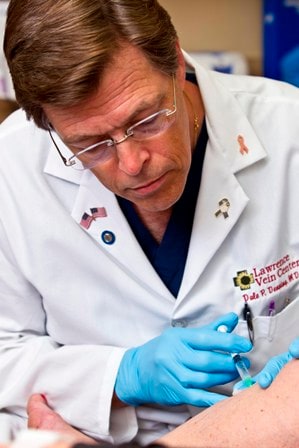Off and on for nearly a year, Lawrence resident Anna Foote experienced unusual swelling and pain in her left thigh.
“My leg was always sore,” she said. “I experienced constant tiredness; all I wanted to do was sit.”
 After the discomfort became too much to bear, Foote visited the Lawrence Vein Center for a consultation with Dr. Dale Denning. He determined that Foote’s pain was the result of varicose veins.
After the discomfort became too much to bear, Foote visited the Lawrence Vein Center for a consultation with Dr. Dale Denning. He determined that Foote’s pain was the result of varicose veins.
According to the National Institutes of Health, vein disease affects about 50 percent of the population. You often can spot varicose veins easily because they are visible above the skin and appear to be bulging or twisted. They are more common in women but also occur in men.
Varicose veins typically develop when valves in the veins become weak or damaged. This can cause blood to pool in the veins, making them expand and become weak. Similar to varicose veins but much smaller, spider veins are thin, threadlike veins that lie close to the skin’s surface. Spider veins can be caused by the backup of blood, hormone changes, exposure to the sun or injury.
In the past, varicose veins were treated by surgically removing — or stripping — the troublesome veins from the leg. According to the American College of Phlebology, advancements in the understanding and treatment of vein disease and disorders have led to less invasive treatments. This means that vein conditions can be treated without a lot of the negative impacts that patients used to experience.
Foote’s condition was treated using a minimally invasive therapy for varicose veins and venous insufficiency called Venacure-EVLT. EVLT stands for Endovenous Laser Therapy. Guided by ultrasound imaging, a special thin fiber is inserted through a very small entry point in the skin. A laser light is emitted through the fiber, and as the fiber is pulled back through the vein, it delivers just the right amount of energy to cause the vein to close and seal shut. Once the vein is sealed, blood then naturally reroutes to healthy veins.
As a result of her procedure, Foote experienced a complete lifestyle change.
“For several weeks after my treatment, Dr. Denning told me it was crucial that I walk five to 15 minutes every hour,” Foote said. “Before, it had been a habit of mine to sit at my desk all day.”
By incorporating more time to get up, walk, and stretch throughout the day, Foote became an avid walker, spending up to 45 minutes each day walking for her health. “I could not feel better about the outcome,” she said.
Dr. Denning said, “Vein problems can be hereditary, but they can also be caused by too much inactivity, like sitting or standing for long periods of time — both contributing factors to Anna’s disease.”
The U.S. Department of Health and Human Services lists the following risk factors for varicose and spider veins:
- Increasing age. As you get older, the valves in your veins may weaken and not work as well.
- Medical history. Being born with weak vein valves increases your risk. Having family members with vein problems also increases your risk. About half of all people who have varicose veins have a family member who has them, too.
- Lack of movement. Sitting or standing for a long time may force your veins to work harder to pump blood to your heart. This may be a bigger problem if you sit with your legs bent or crossed.
- Hormonal changes. These occur during puberty, pregnancy and menopause. Taking birth control pills and other medicines containing estrogen and progesterone also may contribute to the formation of varicose or spider veins.
- Pregnancy. An increase in the amount of blood in the body during pregnancy can cause veins to enlarge. The growing uterus also puts pressure on the veins. Varicose veins usually improve within three months after delivery. More varicose veins and spider veins usually appear with each additional pregnancy.
- Obesity. Being overweight can put extra pressure on your veins.
For more about treatment options for varicose and spider veins, visit lmh.org/veincenter or call Lawrence Vein Center at 785-856-VEIN (8346).
Janice Early, MBA, is Vice President of Marketing and Communications at Lawrence Memorial Hospital, which is a major sponsor of WellCommons.